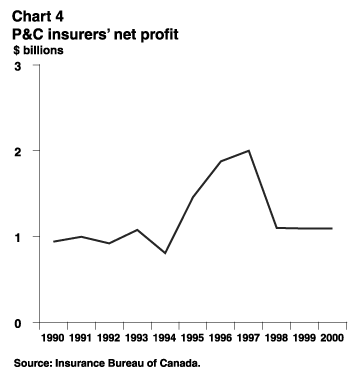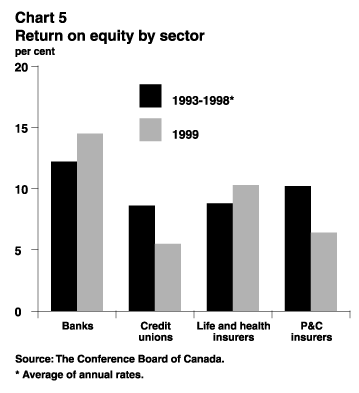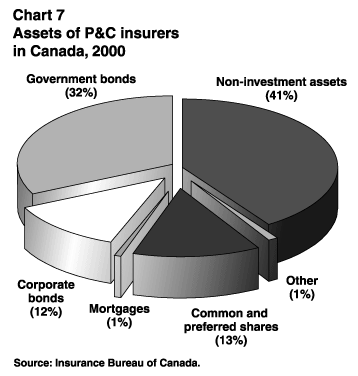|
|
- Previous version - All Financial Sector Fact Sheets -
Canada’s Financial Services Sector
Property and Casualty Insurance in Canada
Updated Version (November 2001)
Overview
- The property and casualty (P&C) insurance industry in Canada, which provides coverage for all risks other than life, generated more than $20 billion in net premiums in 2000. Most premiums are accounted for by automobile, property and liability insurance.
- P&C insurers and their intermediaries employ over 90,000 people in Canada.
- The industry has a wide variety of participants, ranging beyond direct insurers to include reinsurers, government participation in personal auto insurance, and self-insurance arrangements such as reciprocal insurance exchanges and "captive" insurers.
- Canada’s P&C insurance industry is not very concentrated, with about 230 insurers actively competing and the largest one having a market share of 9.9 per cent.
- The P&C insurance industry in Canada realized a profit of over $1 billion in 2000, virtually unchanged since 1998.
- While it is too early to fully assess the impacts of the recent acts of terrorism on the industry, first indications are that Canadian insurers will not be greatly affected by these tragic events.
- The Property and Casualty Insurance Compensation Corporation (PACICC) is an industry-financed policyholder protection scheme for most policies issued by P&C insurance companies in Canada. PACICC guarantees payments up to $250,000 per claim, less deductibles, should an insurer become insolvent.
- The P&C insurance industry consists of domestic companies as well as foreign companies, which can enter through branches or through separately capitalized subsidiaries. Foreign participants have a strong position in Canada’s P&C market, accounting for approximately 66 per cent of net premiums earned.
- The federal government and the provinces share jurisdiction over insurance regulation in Canada. P&C insurers can be incorporated under either level of government; the federal government supervises three-quarters of P&C insurers, which account for more than 80 per cent of total business.
Introduction
The Canadian property and casualty (P&C) insurance industry helps underpin the Canadian economy by assuming the financial risk inherent in many personal and business activities. In other words, the losses of a few are shared among all policyholders, making the lives of individuals and businesses more financially stable and making it easier for them to plan for the future. The industry is generally defined as including all lines of insurance other than life and health, although there are a few companies that sell a limited amount of sickness and accident insurance.
In 2000 over half of the more than $20 billion in premiums was generated from automobile insurance, with most of the remainder coming from property (personal and commercial) and liability insurance (see Chart 1). Government-owned corporations earned an additional $4.1 billion in auto insurance premiums in Quebec, Manitoba, Saskatchewan and British Columbia.1
Structure of the P&C Insurance Industry in Canada
The diversity and the competitiveness of P&C insurance lines available in Canada is reflected in the large number and wide variety of industry participants, with about 230 insurers actively competing in Canada. Canada’s P&C market has attracted considerable interest from foreign companies, which can enter through branches or through separately capitalized subsidiaries. Six of the 10 largest insurers are now foreign-owned, with foreign insurers accounting for about 66 per cent of net premiums earned. While most of the P&C insurance industry in Canada is accounted for by stock companies, about 16 per cent of net premiums are written by mutual companies, which are owned by policyholders.

In line with international trends, Canada’s P&C market has been undergoing a period of consolidation. While in 1980 the 26 largest insurers wrote 50 per cent of net premiums, by 2000 the top 9 insurers served just under half of the market (see the Annex for a list of the top 10 insurers by net premiums written). However, despite the ongoing consolidation, no single P&C insurer has more than 10 per cent of the Canadian market. In addition, more than 20 new P&C insurers entered the Canadian market in the 1990s.
Besides the more than 30,000 employees of primary insurers, Canada has an extensive network of stand-alone insurance intermediaries employing almost 63,000 people. These intermediaries include independent brokers and agents as well as independent insurance adjusters and appraisers, who participate in the assessment of P&C insurance claims. Employment in the P&C insurance industry is concentrated in Ontario and Quebec (see Chart 2).

Government-owned corporations also provide some P&C insurance. The area of greatest government participation is auto insurance, with provincial-government-owned companies supplying this type of insurance in British Columbia, Manitoba, Saskatchewan and Quebec. The British Columbia, Manitoba and Saskatchewan governments supply collision and liability insurance. In Quebec the government provides only liability insurance, leaving collision insurance to private companies. In total, these provincial-government-owned companies account for about 27.7 per cent of the Canadian auto insurance market.
Reinsurance and Self-Insurance
Direct insurers pay premiums to reinsurers who, in exchange, assume a portion of the risk. The worldwide reinsurance market is an important backstop to Canada’s P&C insurers, who ceded business worth about $1.5 billion to reinsurers in 2000. Although this represents only 7.5 per cent of net premiums written, appropriate use of reinsurance is particularly important in managing low probability-high loss events such as severe weather incidents. Reinsurers and reinsurance brokers are not required to register with Canadian supervisory authorities but may choose to do so. Canada’s direct insurers are, however, subject to regulatory controls in their use of reinsurers. These controls include a focus on the financial health of reinsurance companies as well as a 75-per-cent limit on the percentage of a direct insurer’s business that can be reinsured. In addition, there is a 25-per-cent limit on the amount of business that can be ceded by direct insurers to unregulated reinsurers.
For direct insurers, an alternative to reinsurance is the formation of insurance pools under which direct insurers agree to share certain types of risk. Examples of insurance pools in Canada include Canadian Industrial Risks Insurers and the Canadian Aviation Insurance Group.
Some firms also participate in various self-insurance arrangements. One such mechanism is a reciprocal insurance exchange, whereby members of a group involved in a related activity agree to share certain kinds of risk. In Canada a number of school boards, hospitals and universities have established such reciprocal exchanges.
Another self-insurance mechanism of increasing importance is the ownership by one or more Canadian firms of a "captive" insurer. Captive insurers are firms, typically owned by commercial companies, that undertake some or all of their owners’ insurance business. There are many reasons for a parent company to form a captive insurer, such as meeting unique insurance needs, providing a self-funding mechanism, reducing the impact of the insurance industry’s underwriting price cycle, providing opportunities for the organization to improve risk management and increasing control over funds flowing through the organization. Some captive insurers are established under the terms of British Columbia’s Insurance (Captive Company) Act. Under this act, captive insurers can benefit from less onerous licensing requirements, which allow for lower minimum capital. Other captive insurers established by Canadian companies are domiciled in offshore centres, such as Bermuda or the Bahamas, on the condition that captives limit themselves to providing a reinsurance function to the Canadian market.
Profitability and Investment
The business of P&C insurers can be divided into two segments: underwriting and investments. As in other countries such as the U.S., P&C insurance activities in Canada normally result in underwriting losses for most major product lines. This means that premiums paid for policies each year do not generate enough revenue to cover outgoing claims and expenses. However, these underwriting losses are normally more than offset by the investment income generated from assets held by the industry. Underwriting losses are often calculated by the combined ratio – the ratio of the sum of claims incurred and operating expenses to net premiums earned. A ratio greater than 100 per cent indicates an underwriting loss.
The aggregate combined ratio for companies operating in Canada has fluctuated in recent years. It fell from 111.2 per cent in 1991 to 102.6 per cent in 1997, but increased to 107.8 per cent in 1998 largely due to claims related to the ice storm. The following year the combined ratio declined once more to 105.9 per cent, but rose again to 108.3 per cent in 2000, due again to increased claims costs (see Chart 3).

Given these underwriting losses, the profitability of P&C insurers is highly dependent on and sensitive to small changes in investment returns. Despite underwriting losses of about $1.6 billion dollars in 2000, the industry realized a profit of over $1 billion due to its investment income. Chart 4 shows net profit for the industry over the past decade. The decline in profitability since 1997 is principally attributable to considerable claims growth, particularly in automobile insurance.

While the combined ratio is a useful measure for comparing P&C insurers, return on equity allows for comparison between different types of financial institutions. From 1993 to 1998 the return on equity of P&C insurers averaged 10.2 per cent, below the 12.2 per cent for banks but above the 8.8 per cent for life and health insurers and 8.6 per cent for credit unions (see Chart 5). In 1998 return on equity for P&C insurers fell to 6.8 per cent due mainly to claims related to the ice storm (see Chart 6). In 1999 and 2000 there was little change due mainly to lower investment income and rising claims costs.

Since P&C policies are often subject to renewal every year, insurance companies generally match their liabilities by investing in short-term highly liquid investments. P&C insurers’ assets can be divided into two categories: about 40 per cent are in non-investment assets (real and fixed assets, investments in affiliates, accounts receivable, less than one year term deposits, cash and miscellaneous) and the remaining portion is invested prudently, as required by government regulation, in government and corporate bonds, common and preferred shares and mortgages (see Chart 7).


Regulatory and Legal Environment
The federal and provincial governments share jurisdiction over insurance matters in Canada; therefore both levels of government are involved in the regulation and supervision of participants in Canada’s P&C insurance industry. Federal authorities look after the solvency of companies incorporated federally as well as Canadian branch operations of firms incorporated outside Canada. Provincial authorities are responsible for the solvency of provincially incorporated insurers, for reviewing and interpreting insurance contracts and for licensing and supervising agents and adjusters.
Approximately three-quarters of the P&C insurers active in Canada are supervised by the federal government through the Office of the Superintendent of Financial Institutions (OSFI), as they operate in more than one province or are branches of foreign companies. These federally regulated insurers make up more than 80 per cent of the total business of the P&C insurance industry in Canada. Federally regulated companies must, however, also be licensed in each province and territory in which they undertake insurance activities.
P&C insurers in Canada must satisfy regulatory authorities that their policy reserves are sufficient to meet the anticipated requirements of their policyholders. In addition, they must satisfy capital requirements, which are expressed as a minimum percentage by which assets must exceed liabilities. In this regard, OSFI administers the Minimum Asset Test for federally regulated insurers. Since 1999 the Dynamic Capital Adequacy Testing (DCAT) must also be filed with OSFI every year. DCAT is a formal approach to test the financial strength of a company by projecting its future financial condition under various possible sets of consistent scenarios. DCAT enables the systematic quantification of the major business risks faced by an insurance company.
Canadian financial institutions in other areas of the financial services sector are subject to legislative and regulatory restrictions on their participation in Canada’s P&C insurance industry. For example, banks and other federally chartered deposit-taking institutions may own insurance underwriting subsidiaries, but they are generally not permitted to become directly involved in the retailing of insurance through their branches. However, they are allowed limited participation in some lines related to their banking activities, such as credit card and travel insurance.
Canadians are permitted to purchase insurance from insurers not licensed in Canada. However, the extent to which these unlicensed insurers can solicit business in Canada from Canadians is strictly limited and monitored by the regulatory authorities.
Policyholder Protection
Additional protection for many Canadian policyholders is provided by the industry-run Property and Casualty Insurance Compensation Corporation (PACICC), which has guaranteed most P&C insurance policies in Canada, up to certain limits, since 1988.2 PACICC membership is required in all Canadian jurisdictions for the licensing of P&C insurers in PACICC-covered lines. PACICC has established a reserve fund of approximately $30 million. In addition, it has the power to levy assessments on its members should an insolvency occur. Foreign insurers with branches in Canada must vest assets in Canada to ensure policyholder protection.
Key Industry Issues
Acts of Terrorism
The recent terrorist attacks in the United States, in addition to being a great human tragedy, will likely lead to one of the largest insurance payouts in history. While it is too early to know the total amount of the claims, first indications are that Canadian insurers will not be greatly affected by these events.
Increased Risk of Natural Catastrophe
The increased frequency and severity of natural disasters is also a key issue of concern to the P&C insurance industry. According to the Insurance Bureau of Canada (IBC), the cost of natural disasters to insurers and taxpayers rose from $750 million in 1993 to $1.5 billion in 1997. In 1998 the cost doubled again to $3 billion because of the ice storm in Quebec and Ontario. The main factors leading to this cost escalation are growing population, increasing urbanization, aging infrastructure and climate change. The IBC is a partner in a five-year $7.5-million research program to mitigate the impact of natural disasters. Also, the insurer-based Institute for Catastrophic Loss Reduction has held workshops with government representatives, scientists and experts to examine Canada’s increasing vulnerability to natural hazards.
Financial Services Regulatory Reform
On June 14, 2001, federal legislation reforming the regulatory framework governing the financial services sector (Bill C-8) received Royal Assent. The legislation provides the sector with a framework that promotes efficiency and growth, fosters domestic competition, empowers and protects consumers and improves the regulatory environment. Regulations required to implement certain provisions of the legislation have been drafted and the legislation was proclaimed on October 24, 2001.
The legislation provides for the creation of the Financial Consumer Agency of Canada to enforce the consumer-oriented provisions of the federal financial institution statutes. It also requires P&C insurers to be members of a third-party dispute resolution system to handle the complaints of consumers and small businesses regarding their dealings with P&C companies.
To keep pace with the rapidly changing marketplace, the new framework maintains the practice of reviewing the regulatory framework every five years through a sunset clause in the legislation. The federal government also expressed its willingness to revisit the legislation prior to the five-year review, if necessary, to ensure that the framework remains up to date.
Annex
Top ten P&C insurers in Canada by net premiums written, 2000
|
|
||
|---|---|---|
|
Name |
Country of origin |
Net premiums written |
|
|
||
|
(thousands of dollars) |
||
|
ING Canada |
The Netherlands |
1,993,929 |
|
CGU Group Canada Ltd |
UK |
1,769,018 |
|
Co-operators Group |
Canada |
1,253,793 |
|
Royal & Sunalliance |
UK |
1,214,758 |
|
Economical Insurance Group |
Canada |
943,176 |
|
AXA Canada Inc. |
France |
848,991 |
|
Lloyd’s Underwriters |
UK |
793,022 |
|
State Farm Insurance Companies |
USA |
762,490 |
|
Wawanesa Mutual Insurance Company |
Canada |
673,602 |
|
Groupe Desjardins |
Canada |
639,409 |
|
|
||
|
Source: CI Canadian Insurance, 2000 Annual Statistical Review. |
||
Further information on legislation to reform the financial services sector can be obtained from the Department of Finance at http://www.fin.gc.ca/. Additional information on the P&C insurance industry is available from the Office of the Superintendent of Financial Institutions at http://osfi-bsif.gc.ca/ and from the Insurance Bureau of Canada at http://www.ibc.ca/.
For additional copies, please contact the Distribution Centre at (613) 995-2855
1 This information sheet deals primarily with insurance provided through private companies. Unless otherwise stated, all descriptions and data exclude insurance provided through public sector entities. [Return]
2 PACICC covers policies up to $250,000 and will refund 70 per cent of unused (prepaid) premiums, up to $700, from the date of the insurer’s collapse to the expiration of the policy. [Return]
| Last Updated: 2004-11-03 | |||||